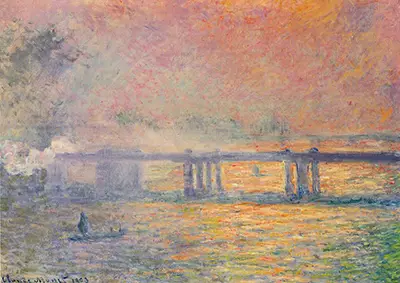Unlike a lot of his paintings that were created near his place of residence, Monet was only visiting London to view the city and possibly gather inspiration. From his hotel, he saw a misty, polluted London that was barely visible at times. The artist found inspiration from the collections of Turner and Constable found in various art institutions and museums around the city.
From this, he created foggy impressionistic paintings of Charing Cross Bridge, the House of Parliament and other London landmarks. Monet repeated these creations several times over and did not merely create one version of one sight.
Forever capturing the atmosphere of a setting, Monet made sure to get across how much smog hovered over the large city.
Monet seemed to do the impossible with his paintings: he froze time in the busy city and portrayed slow-moving, almost idle features that sailed underneath the bridge itself. One particular painting of the Charing Cross Bridge created in 1901 takes place in winter where London is dark and not as vibrant.
Through the mist, the sillhouette of the buildings of London can be seen, almost giving the painting a mysterious, hazy effect. There are similarities with Impression, Sunrise.
Monet has always utilised light in order to create dimension and movement in his paintings and this work is no different. Monet masters the light that breaks through the mist and reflects off the fluid water. Monet later recalled after creating this series that he was in love with London, particularly in the winter season. He believed it was the thick mist that made the city so beautiful and endearing.
The way Monet captures the city drenched in smog, it is almost alike to a ghost town with its residents lurking in the calm, placid darkness.
The Industrial Revolution is thought by many to have brought misery to the people of London. It caused people to live in squalor, disease and poverty and stretched out to build upon the rural areas that citizens called their home. Though bringing England into a new era and giving them superiority over the rest of the world, it was not perceived as a gift to many.
Despite the fact Monet was a visitor, for him to capture the beauty of such a controversial and perhaps unhappy time for the people of London, is quite an achievement and displays the true power of art.
Monet created many paintings of London, over 100. He chose to focus on a small number, however and did not finish those particular creations in London. Instead, he brought them back to his studio in France where he finished them there.
The paintings were purchased as soon as 1913, 12 years after the series had ended, possibly showing its popularity and beauty and the craftmanship of Monet. Not all of the paintings in the series were a success, however, proving that even masters can struggle.


